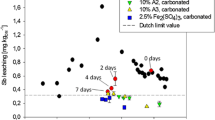The solidification of partially evaporated bottoms of RBMK and VVER with salt concentration 500–650 g/liter by compositional binders consisting of Portland cement and silicic additives – aerosil, microsilica, opoka, silicic acid, liquid glass, and diatomite is examined. The additions were used to obtain matrices that satisfy the requirements of safe storage of cemented radwastes. The partition coefficients of 137Cs in partially evaporated bottoms are determined for all additives studied. The most effective additive for solidification of partially evaporated bottoms of VVER is diatomite. Matrices with diatomite have strength 50–81 kg/cm2, the rate of leaching of 137Cs ~ 10–3–10–4 g/(cm2·day) and the fill with respect to salts reaches 20.9 wt.%. On the solidification of partially evaporated RBMK bottoms the most effective hardening additives are aerosil and microsilica and the most effective sorbing additives are bentonite, opoka, and diatomite. The matrices so obtained have strength 59–93 kg/cm2, 137Cs leach rate ~ 10–3–10–4 g/(cm2·day) and contain to 25.1 wt.% salts.
Similar content being viewed by others
References
I. A. Sobolev and L. M. Khomchik, Neutralization of Radioactive Wastes at Centralized Points, Energoatomizdat, Moscow (1983).
GOST R 51883–2002, Cemented Radwastes. General Technical Requirements, Izd. Standartov, Moscow (2002).
Yu. I. Belov, V. V. Proskuryakova, V. P. Mikhailov, et al., Russian Patent No. 2055409, “Method of solidifying liquid radwastes for nuclear power plants,” Byull. Izobr., Polez. Modeli, No. 6, 161 (1996).
P. V. Kozlov, O. M. Slyunchev, and K. V. Kiryanov, Russian patent No. 2375773, “Composition for cementing liquid radwastes,” Byull. Izobr., Polez. Modeli, No. 34, 310 (2009).
K. P. Zakharova, O. M. Khimchenko, L. P. Sukhanov, et al., “Development of the technological regime for cementing salt concentrates from the Volgodonskaya nuclear power plant,” At. Énerg., 103, No. 5, 309–314 (2007).
GOST 310.4-81 (1992), Cements. Methods for Determining the Maximum Bending and Compression Strength, Izd. Standartov, Moscow (1992).
GOST 310.3-76 (1992), Cements. Methods for Determining the Normal Thickness, Setting Times, and Uniformity of the Volume Change, Izd. Standartov, Moscow (1992).
GOST 310.6-85 (1992), Cements. Methods for Determining Water Separation, Izd. Standartov, Moscow (1992).
GOST R 52126-2003, Radwastes. Determination of the Chemical Stability of Solidified High-Level Wastes by the Method of Long-Term Leaching, Izd. Standartov, Moscow (2003).
GOST 10060.1-95, Concretes. Base Method of Determining the Freeze Resistance, Izd. Standartov, Moscow (1996).
N. G. Bogdanovich, E. A. Grushicheva, T. O. Mishevets, et al., “Investigation of the sorption properties of natural inorganic materials: extraction of 137Cs and 90Sr by finely disperse sorbents under static conditions,” Radiokhim., 50, No. 4, 345–350 (2008).
Author information
Authors and Affiliations
Additional information
Translated from Atomnaya Énergiya, Vol. 109, No. 4, pp. 222–227, October, 2010.
Rights and permissions
About this article
Cite this article
Kononenko, O.A., Gelis, V.M. & Milyutin, V.V. Incorporation of bottoms from nuclear power plants into a matrix based on portland cement and silicic additives. At Energy 109, 278–284 (2011). https://doi.org/10.1007/s10512-011-9357-9
Received:
Published:
Issue Date:
DOI: https://doi.org/10.1007/s10512-011-9357-9




